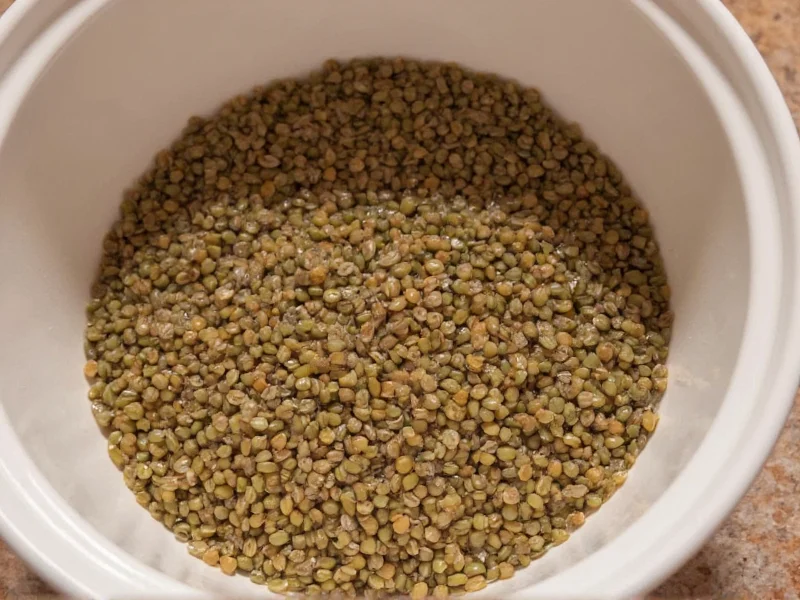Understanding whether and how to soak lentils properly can transform your cooking experience and digestive comfort. While lentils are among the quickest legumes to prepare, optimizing your soaking technique delivers noticeable benefits in both kitchen efficiency and nutritional value.
Why Soaking Lentils Matters
Unlike beans that almost always require soaking, lentils occupy a middle ground in legume preparation. The decision to soak depends primarily on lentil variety and your cooking goals. Soaking works by initiating enzymatic processes that break down complex compounds, particularly phytic acid and oligosaccharides that can cause digestive discomfort.
When you soak lentils properly, you activate natural enzymes that begin breaking down hard-to-digest components. This pre-digestion process makes nutrients more bioavailable while reducing compounds that cause gas and bloating. The water used for soaking actually pulls out these anti-nutrients, which is why discarding soaking water provides digestive benefits.
Lentil Varieties and Their Soaking Requirements
Not all lentils respond equally to soaking. Understanding the differences between varieties helps you make informed preparation choices:
| Lentil Type | Soaking Recommended? | Optimal Soaking Time | Typical Cooking Time (Unsoaked) |
|---|---|---|---|
| Red lentils | No | Not necessary | 15-20 minutes |
| Yellow lentils | No | Not necessary | 15-20 minutes |
| Green/brown lentils | Optional | 2-4 hours | 25-30 minutes |
| French green (Puy) | Recommended | 2-4 hours | 30-35 minutes |
| Black beluga | Recommended | 2-4 hours | 25-30 minutes |
| Whole masoor | Recommended | 4-6 hours | 45-50 minutes |
Science-Backed Benefits of Proper Lentil Soaking
Research shows that appropriate soaking delivers measurable improvements in both nutritional profile and cooking performance. The primary benefits include:
Enhanced Digestibility
Soaking reduces oligosaccharides—complex sugars responsible for gas production—by up to 27% according to studies published in the Journal of Food Science and Technology. This makes properly prepared lentils significantly gentler on sensitive digestive systems.
Reduced Cooking Time
When you soak larger lentil varieties for 2-4 hours, you can decrease cooking time by 20-25%. This energy-efficient approach preserves more nutrients that might otherwise degrade during extended cooking.
Improved Nutrient Availability
Phytic acid naturally present in lentils binds minerals like iron and zinc, reducing their absorption. Soaking activates phytase enzymes that break down phytic acid, increasing mineral bioavailability by approximately 20% based on research from the International Journal of Food Sciences and Nutrition.
Step-by-Step Guide to Soaking Lentils Properly
Follow these professional chef-recommended steps for optimal results:
- Sort and rinse: Spread lentils on a clean surface to check for debris, then rinse thoroughly under cold water
- Use proper ratio: Combine 1 cup lentils with 3 cups cool, filtered water in a non-reactive bowl
- Add acid (optional but recommended): Include 1 tablespoon lemon juice or apple cider vinegar to enhance phytic acid breakdown
- Soak duration: Leave at room temperature for 2-4 hours (never exceed 12 hours to prevent fermentation)
- Final rinse: Drain and rinse lentils thoroughly before cooking to remove released compounds
Common Soaking Mistakes to Avoid
Even experienced cooks make these critical errors that undermine the benefits of soaking:
- Over-soaking: Leaving lentils in water longer than 12 hours causes nutrient loss and potential fermentation
- Using warm water: Warm temperatures encourage bacterial growth; always use cool water
- Skipping the final rinse: Failing to rinse after soaking leaves anti-nutrients on the lentils
- Soaking red/yellow lentils: These small varieties break down too quickly when soaked
- Adding salt during soaking: Salt hardens lentil skins, counteracting the softening effect
What Happens If You Skip Soaking?
While you can cook most lentils without soaking, understanding the trade-offs helps you make informed decisions. Unsoaked larger lentils typically require 25-30% more cooking time and may cause more digestive discomfort for sensitive individuals. The texture might be slightly less uniform, with some lentils overcooking while others remain firm.
For red and yellow lentils—which naturally break down into a creamy texture—skipping soaking makes no practical difference. These varieties cook so quickly (15-20 minutes) that soaking provides minimal time savings while potentially causing them to become mushy.
Advanced Techniques for Maximum Benefits
For those seeking optimal results, consider these professional techniques:
- Warm soaking: For maximum phytate reduction, use the method described in Food Chemistry journal: soak at 50°C (122°F) for 12 hours
- Extended soaking with water changes: For highly sensitive digestive systems, soak for 8-12 hours with water changed every 4 hours
- Acidulated soaking: Adding vinegar or lemon juice to soaking water increases phytase activity by up to 50% according to research











 浙公网安备
33010002000092号
浙公网安备
33010002000092号 浙B2-20120091-4
浙B2-20120091-4